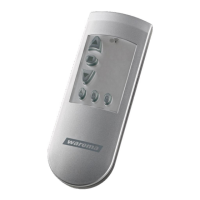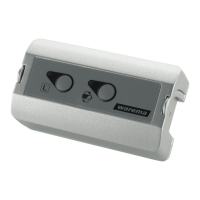Operating and installation instructions
EWFS hand-held transmitter 1/8-channel
Keep for future use!
Valid from 1st january 2016
866082_h•en•2016-01-01
We reserve the right to carry out improvements
1
General
Fig. 1 1-channel hand-held transmitter
Fig. 2 8-channel hand-held transmitter
The EWFS hand-held transmitter allows wireless opera-
tion of an EWFS-compatible receiver and is available as a
1-channel or 8-channel version.
Intended use
The device was developed to control WAREMA EWFS
receivers. The approval of the manufacturer must be
obtained for uses outside of the purposes listed in these
instructions.
Safety instructions
CAUTION
Never activate buttons on your transmitter
arbitrarily without visual contact to the sun
shading product. Children may not play with
this product - Remote controls or transmit-
ters may not get into the hands of children!
Carry out the following steps in the sequence given to
ensure problem-free operation:
n Please read these instructions carefully
n Insert the batteries
n Learn the hand-held transmitter into the receivers
n Check that the system is functioning correctly
Commissioning
Films on commissioning can be found at:
http://www.warema.de/inbetriebnahme-
funksysteme
n Insert the supplied batteries into the battery compartment as
described in the "Maintenance" section. The device is then
ready to operate.
n Learn the hand-held transmitter into the receivers. Use the
"Learn" button to this purpose. For information about the topic
of "learning" please refer to the operating and installation in-
structions of the receivers.
Operating elements on the front
7
6
A
1
2
3
4
5
6
7
8
B
C
-
+
AB
C
1
2
3
4
5
Fig. 3 Control panel 1-channel hand-held transmitter (left),
Control panel 8-channel hand-held transmitter (right)
1
The transmission LED comes on when a move com
mand is sent. If the batteries are depleted, this LED
flashes when sending a move command. The LED
does not come on when the battery is completely
drained.
2 "Up" button, raises the sun shading.
3 "Stop" button, stops a move command.
4 "Down" button, lowers the sun shading.
5 Function buttons, trigger special functions in the
receiver:
"A" button": Switches the sun control on and off
"B" button": Switches the lighting on and off
"C" button": Saves the comfort position and calls it up
again
6 Channel buttons "+" or "-" are used for the channel
selection.
7 Channel indicator, shows which channel was selected.
Selecting a channel: Pressing the "+" or "-" selects a
channel. This is indicated by a channel LED lighting
up. The channels are changed consecutively when the
channel buttons are pressed several times


